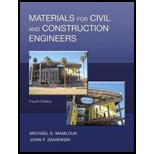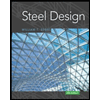
The design engineer specifies a concrete strength of 5500 psi. Determine the required average compressive strength for:
- a. a new plant where s is unknown
- b. a plant where s = 500 psi for 22 test results
- c. a plant with extensive history of producing concrete with s = 400 psi
- d. a plant with extensive history of producing concrete with s = 600 psi
(a)
The required average compressive strength for a new plant when standard deviation (s) is unknown.
Answer to Problem 7.1QP
The required average compressive strength for a new plant when s is unknown is
Explanation of Solution
Given information:
The concrete strength
Calculation:
Determine the required average compressive strength for a new plant
Here, s is the standard deviation.
Take standard deviation as 1,400 psi for compressive strength greather then 5,000 psi.
Substitute 5,500 psi for
Therefore, required average compressive strength for a new plant when standard deviation (s) is unknown is
(b)
The required average compressive strength for a new plant when standard deviation (s) is 500 psi.
Answer to Problem 7.1QP
The required average compressive strength for a new plant when standard deviation (s) is 500 psi
Explanation of Solution
Given information:
The concrete strength
Calculation:
Determine the modification factor for 22 number of test
Here,
Substitute 1.03 for
Determine the modified standard deviation
Substitute 500 psi for s and 1.06 for
Determine the required average compressive strength for a new plant
Here, s is the standard deviation.
Substitute 5,500 psi for
Determine the required average compressive strength for a new plant
Substitute 5,500 psi for
Take the maximum value from the calculated
Use
Therefore, the required average compressive strength for a new plant when standard deviation (s) is 500 psi is
(c)
The required average compressive strength for a plant with extensive history of producing concrete with standard deviation (s) of 400 psi.
Answer to Problem 7.1QP
The required average compressive strength for a plant with extensive history of producing concrete with standard deviation (s) of 400 psi is
Explanation of Solution
Given information:
The concrete strength
Calculation:
Determine the required average compressive strength for a new plant
Substitute 5,500 psi for
Determine the required average compressive strength for a new plant
Substitute 5,500 psi for
Take the maximum value from the calculated
Use
Therefore, the required average compressive strength for a plant with extensive history of producing concrete with standard deviation (s) of 400 psi is
(d)
The required average compressive strength for a plant with extensive history of producing concrete with standard deviation (s) of 600 psi.
Answer to Problem 7.1QP
The required average compressive strength for a plant with extensive history of producing concrete with standard deviation (s) of 600 psi is
Explanation of Solution
Given information:
The concrete strength
Calculation:
Determine the required average compressive strength for a new plant
Substitute 5,500 psi for
Determine the required average compressive strength for a new plant
Substitute 5,500 psi for
Take the maximum value from the calculated
Use
Therefore, the required average compressive strength for a plant with extensive history of producing concrete with standard deviation (s) of 600 psi is
Want to see more full solutions like this?
Chapter 7 Solutions
Materials for Civil and Construction Engineers (4th Edition)
Additional Engineering Textbook Solutions
Starting Out with Programming Logic and Design (5th Edition) (What's New in Computer Science)
Java How to Program, Early Objects (11th Edition) (Deitel: How to Program)
Electric Circuits. (11th Edition)
Management Information Systems: Managing The Digital Firm (16th Edition)
Starting Out with Python (4th Edition)
Thinking Like an Engineer: An Active Learning Approach (4th Edition)
- E:/school%20pack/BENG%202/EG231/STATICS/LECTURE%20NOTES/PRACTICE%20QUESTIONS/EG%20231%20Chap-5%20Practice%20Que PDF 豆豆豆豆豆豆 aw V Aa | Ask Copilot - + 4 of 8 D 3. Calculate the y-coordinate of the centroid of the shaded area. 74 mm y 3232 mm mm DELL 32 mm -x F1 F2 F3 F4 F5 F6 F7 F8 F9 prt sc F10 home end F11 F 2 W E3 $ 4 € 95 % & 6 7 8 * 00 R T Y כ 9 O Parrow_forward*8-60. The 2-in.-diameter rod is subjected to the forces shown. Determine the state of stress at point B, and show the results on a differential element located at this point. Probs. 8-59/60 B 8 in. 600 lb 12 in. 500 lb 800 lbarrow_forwardfind SFD and BMD by using slope deflection methodarrow_forward
- The following relates to Problems 4 and 5. Christchurch, New Zealand experienced a major earthquake on February 22, 2011. It destroyed 100,000 homes. Data were collected on a sample of 300 damaged homes. These data are saved in the file called CIEG315 Homework 4 data.xlsx, which is available on Canvas under Files. A subset of the data is shown in the accompanying table. Two of the variables are qualitative in nature: Wall construction and roof construction. Two of the variables are quantitative: (1) Peak ground acceleration (PGA), a measure of the intensity of ground shaking that the home experienced in the earthquake (in units of acceleration of gravity, g); (2) Damage, which indicates the amount of damage experienced in the earthquake in New Zealand dollars; and (3) Building value, the pre-earthquake value of the home in New Zealand dollars. PGA (g) Damage (NZ$) Building Value (NZ$) Wall Construction Roof Construction Property ID 1 0.645 2 0.101 141,416 2,826 253,000 B 305,000 B T 3…arrow_forwardfind SFD and BMDarrow_forwardThe data needed to answer this question is given by this link: https://docs.google.com/spreadsheets/d/1vzb03U7Uvzm7X-by3OchQNwYeREzbP6Z-xzZMP2tzNw/edit?usp=sharing if it is easier to make a copy of the data because it is on view only then feel free to do so.arrow_forward
- The data needed to answer this question is given in the following link (file is on view only so if you would like to make a copy to make it easier for yourself feel free to do so) https://docs.google.com/spreadsheets/d/1aV5rsxdNjHnkeTkm5VqHzBXZgW-Ptbs3vqwk0SYiQPo/edit?usp=sharingarrow_forwardA k 000 6 ft A kips Bl D ft C C kips 10 ft 12 ft E B k/ft D E ft tarrow_forwardH.W: show that the equations 1. (x+y)dy+(x-y)dx = 0 2. x²dy+(y²-xy)dx = 0 are homogeneous and solve:arrow_forward
- H.W: Solve the differential equation y' - (1+x)(1 + y²) = 0arrow_forwardThe benchmark is 00.00. The backsights are 6.00, 9.32 and 13.75 and 14.00 The foresights are 6.00, 9.00 and 3.22. What is the height of the instrument? H.I. - 100.00 - 124.85 - 43.07- 24.85arrow_forwardThe benchmark is 100.00. The backsights are 4.00, 6.32 and 12.75. The foresights are 6.00, 9.00 and 3.22. What is the elevation of the point? - 95.14 - 123.08 - 104.85 - 81.78arrow_forward
 Materials Science And Engineering PropertiesCivil EngineeringISBN:9781111988609Author:Charles GilmorePublisher:Cengage Learning
Materials Science And Engineering PropertiesCivil EngineeringISBN:9781111988609Author:Charles GilmorePublisher:Cengage Learning Traffic and Highway EngineeringCivil EngineeringISBN:9781305156241Author:Garber, Nicholas J.Publisher:Cengage Learning
Traffic and Highway EngineeringCivil EngineeringISBN:9781305156241Author:Garber, Nicholas J.Publisher:Cengage Learning Fundamentals Of Construction EstimatingCivil EngineeringISBN:9781337399395Author:Pratt, David J.Publisher:Cengage,
Fundamentals Of Construction EstimatingCivil EngineeringISBN:9781337399395Author:Pratt, David J.Publisher:Cengage, Construction Materials, Methods and Techniques (M...Civil EngineeringISBN:9781305086272Author:William P. Spence, Eva KultermannPublisher:Cengage Learning
Construction Materials, Methods and Techniques (M...Civil EngineeringISBN:9781305086272Author:William P. Spence, Eva KultermannPublisher:Cengage Learning Fundamentals of Geotechnical Engineering (MindTap...Civil EngineeringISBN:9781305635180Author:Braja M. Das, Nagaratnam SivakuganPublisher:Cengage Learning
Fundamentals of Geotechnical Engineering (MindTap...Civil EngineeringISBN:9781305635180Author:Braja M. Das, Nagaratnam SivakuganPublisher:Cengage Learning Steel Design (Activate Learning with these NEW ti...Civil EngineeringISBN:9781337094740Author:Segui, William T.Publisher:Cengage Learning
Steel Design (Activate Learning with these NEW ti...Civil EngineeringISBN:9781337094740Author:Segui, William T.Publisher:Cengage Learning





